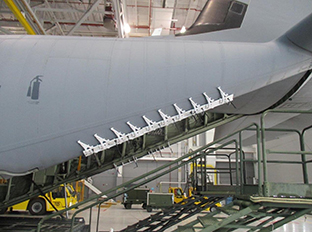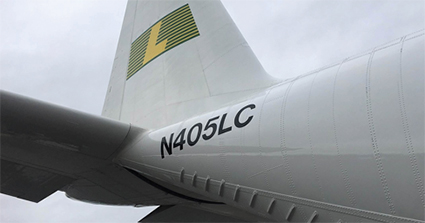Microvanes gaining acceptance
- Latest News
- Thursday, 12 December 2019
 3D-printed Microvanes from Metro Aerospace are attracting growing interest from civilian and military operators of Hercules freighter aircraft.
3D-printed Microvanes from Metro Aerospace are attracting growing interest from civilian and military operators of Hercules freighter aircraft.
Anchorage-based Lynden Air Cargo is currently outfitting its C-130/L-382 fleet with the drag-reducing components, while the Nigerian Air Force has joined other military operators in applying the modification.
Microvanes are small aerodynamic components that are surface-mounted to the fuselage of the aircraft, effectively reshaping the air flow around the aft cargo door, reducing the total drag on the aircraft and in turn reducing fuel and thrust requirements.
 Metro Aerospace, headquartered in Dallas, Texas, holds the exclusive global licence to manufacture and supply Microvanes, a technology which was invented, tested and patented by Lockheed Martin.
Metro Aerospace, headquartered in Dallas, Texas, holds the exclusive global licence to manufacture and supply Microvanes, a technology which was invented, tested and patented by Lockheed Martin.
Lynden installed Microvanes on one of its long-haul Hercules after obtaining FAA STC late last year.
The cargo carrier has reported an improvement in fleet operating efficiencies as well as reducing carbon emissions substantially.
Metro Aerospace says it goes through a rigorous qualification and manufacturing process to ensure each Microvane is high quality and conforms to extremely tight specifications. The material used to build Microvanes is laboratory tested before it can be used to manufacture each 3D printed part.
Density, strength and melting point are all tested to ensure the material can withstand the extreme changes in temperature and pressure that occur on the exterior of an aircraft during flight.
If the material is too brittle, Microvanes could break or crack during long flight hours, but if the material is too flexible they will not create the right vortexes to optimally reduce drag on the aircraft. The Microvanes are subsequently tested after manufacturing to ensure 100 per cent parts conformance.
 The selective laser sintering (SLS) machines used to manufacture Microvanes must also go through a certification and qualification process in order to be used for production.
The selective laser sintering (SLS) machines used to manufacture Microvanes must also go through a certification and qualification process in order to be used for production.
Growing usage data suggests that the addition of Microvanes can provide as much as four per cent fuel savings at cruise conditions, extended time in flight and reduction of inboard engine wear.
Flight testing has also verified no adverse impact on airdrop operations from the aircraft ramp.
Retrofits can be effected with a short lead time, which Metro Aerospace puts at 6-8 weeks from order.
On the web: www.metroaerospace.com
- Kelvin King










